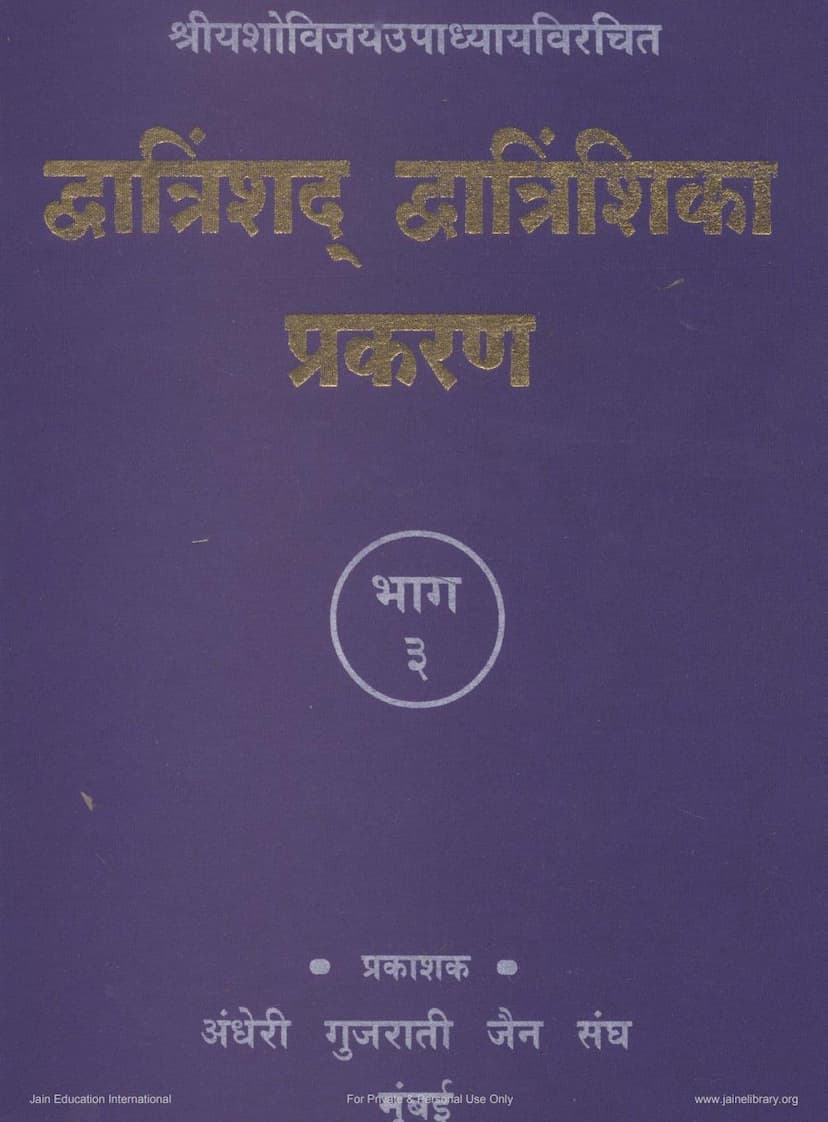Dwatrinshada Dwatrinshika Prakran Part 3
Added to library: September 1, 2025

Summary
The provided text is the third part of the "Dwatrinshada Dwatrinshika Prakran" (द्वात्रिंशद् द्वात्रिंशिका प्रकरण), authored by Yashovijay Upadhyay and Yashovijay of Jayaghoshsuri. It was published by the Andheri Gujarati Jain Sangh in Mumbai.
This particular volume, Part 3, covers the ninth through thirteenth "Battriśi" (बत्रीसी), which are essentially chapters or sections, each containing thirty-two verses. The title itself, "Dwatrinshada Dwatrinshika," refers to the structure of the larger work, which likely consists of thirty-two such Battriśis, with each Battriśi having thirty-two verses.
The preface highlights the significance of this publication, noting that it presents a new Sanskrit commentary and a Gujarati critique, enriched with the author's own elucidations. The work is described as a grand tome of over 2800 pages, published in eight parts. The "Dwatrinshada Dwatrinshika Prakran" is also known as "Dwatrinshika Prakran" or "Dwatrinshika Prakran" (द्वात्रिंशिका प्रकरण). In Gujarati, it's referred to as "Battis-Battisi" (बत्तीस-बत्तीसी) or "Battisi Prakran" (बत्तीसी प्रकरण).
Key Themes and Content:
- Structure: The text has a total of thirty-two chapters (Battriśi), each with thirty-two verses. Part 3 specifically includes the Ninth to Thirteenth Battriśi.
- Subject Matter: The primary focus of the "Dwatrinshada Dwatrinshika Prakran" is on Yoga and Spirituality (योग और अध्यात्म - Yoga and Adhyatma).
- Author's Approach: The author, Upadhyay Yashovijayji Maharaj, is praised for his ability to elucidate complex and profound spiritual concepts using the sophisticated terminology of Navya Nyaya (नव्य न्याय - Neo-Logic). The publication aims to provide a clear and accessible commentary to bridge this gap for a wider audience.
- Ninth Battriśi: Kathadwatrinshika (कथाद्वात्रिंशिका): This section delves into different types of narratives (Katha), including:
- Arthakatha (अर्थकथा): Narratives focused on wealth acquisition, knowledge, skills, and strategies for achieving worldly prosperity.
- Kamkatha (कामकाथा): Narratives concerning love, beauty, adornment, and sensual experiences.
- Dharmakatha (धर्मकथा): Narratives related to spiritual teachings, ethical conduct, and the path to liberation. This is further categorized into:
- Akshapani (आक्षेपणी): Stories that attract the listener's attention towards Dharma.
- Vikshepani (विक्षेपणी): Narratives that potentially misdirect or confuse listeners about Dharma.
- Samvejani (संवेजन): Stories that evoke a sense of detachment by depicting the dire consequences of negative actions.
- Nirvejani (निर्वेण): Narratives that generate renunciation by highlighting the suffering in worldly existence.
- Mishrakatha (मिश्रकथा): Narratives that combine elements of Dharma, Artha, and Kama.
- Vikatka (विकथा): Stories about everyday life, mundane topics, or those that distract from spiritual pursuits, considered undesirable for monks.
- The text also discusses the importance of the speaker's intention and the listener's disposition in shaping the impact of a narrative.
- Tenth Battriśi: Yogalakshana Dwatrinshika (योगलक्षणद्वात्रिंशिका): This part focuses on the definition and nature of Yoga, exploring:
- Yoga's Goal: Connecting with liberation (Moksha).
- Core Principles: Yoga is considered the primary internal cause for Moksha.
- Obstacles and Timeframes: It discusses the limitations of beings in certain epochs (Acharma Avarta) who are engrossed in worldly pleasures and thus deviate from the path of Yoga.
- Stages of Progress: The text outlines the importance of preliminary practices and the gradual progression towards Yoga through stages like Pradindhana, Vidvajaya, Siddhi, and Viniyoga.
- The Role of Bhava (Inner State): It emphasizes that sincere inner states (Bhava) are more crucial than mere external rituals (Kriya) for spiritual progress and liberation.
- Comparison with Other Traditions: The text engages in a critical analysis of Patanjali's Yoga philosophy, highlighting potential inconsistencies and offering Jain philosophical interpretations. It discusses concepts like the nature of the soul (Atman), Prakriti, and the process of liberation from a Jain perspective.
- Eleventh Battriśi: Patanjalayoga Lakshana Dwatrinshika (पातंत्रजयोगलक्षणाद्वात्रिंशिका): This section specifically examines and critiques the Yoga philosophy of Patanjali, including:
- Patanjali's Definition of Yoga: "Yoga is the cessation of the modifications of consciousness" (Yogaś cittavṛttinirodhaḥ - योगश्चित्तवृत्तिनिरोधः).
- Analysis of Concepts: It scrutinizes concepts like 'Chitta' (consciousness), 'Vritti' (modifications), 'Nirodha' (cessation), 'Abhyasa' (practice), and 'Vairagya' (dispassion).
- Critique of Samkhya and Patanjali: The author points out potential contradictions in the Samkhya and Patanjali views on the soul (Atman) being immutable (Kutastha) versus the concept of transformation, and the singularity of Prakriti (nature) versus the multiplicity of souls.
- Jain Synthesis: The text aims to reconcile or present the Jain understanding of these spiritual concepts.
- Twelfth Battriśi: Purva Seva Dwatrinshika (पूर्वसेवाद्वात्रिंशिका): This part focuses on the preliminary practices (Purva Seva) essential for Yoga, outlining:
- Fivefold Purva Seva: Guru Puja, Dev Puja, Sadachar (good conduct), Tapas (asceticism), and Mukti Dwesh (detachment from liberation itself, or rather, freedom from aversion to liberation).
- Details on Conduct: It elaborates on the importance of honoring elders, parents, teachers, and engaging in virtuous conduct, adhering to righteous practices, and performing austerities with devotion.
- Thirteenth Battriśi: Muktyadwesha Pradhanya Dwatrinshika (मुक्तिद्वेषप्राधान्यद्वात्रिंशिका): This section emphasizes the importance of "Muktyadwesha" (aversion to or detachment from worldly existence), highlighting:
- Detachment from Worldly Desires: The text explains how attachment to worldly pleasures (Bhava) hinders spiritual progress.
- The Role of True Renunciation: It distinguishes between true detachment and mere aversion, emphasizing the former's necessity for spiritual advancement.
- The Influence of Upaya (Means): The importance of right means and practices is discussed, particularly in the context of achieving liberation.
The text is a scholarly work that aims to provide a comprehensive understanding of Yoga and spiritual practices within the Jain tradition, while also engaging with and offering a comparative perspective on other philosophical systems, particularly Yoga philosophy as presented by Patanjali. The author's deep knowledge of Jain Agamas and other philosophical texts is evident throughout the work.